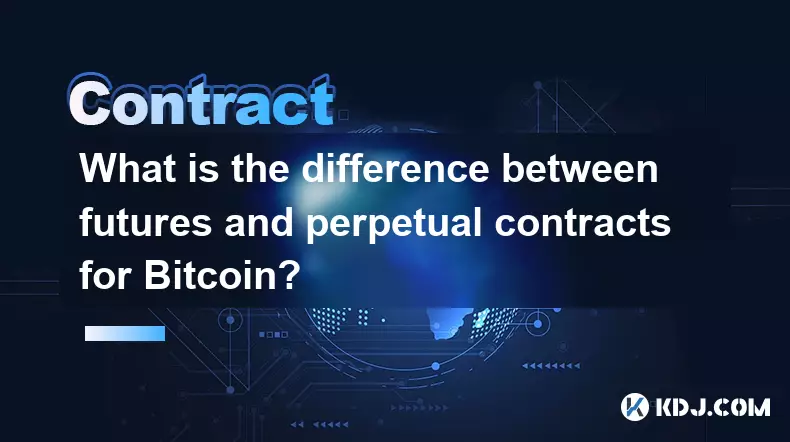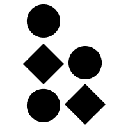-
 bitcoin
bitcoin $123963.239194 USD
1.37% -
 ethereum
ethereum $4529.082464 USD
1.07% -
 xrp
xrp $2.983640 USD
0.71% -
 tether
tether $1.000287 USD
0.02% -
 bnb
bnb $1179.874393 USD
2.99% -
 solana
solana $230.633678 USD
1.55% -
 usd-coin
usd-coin $0.999835 USD
0.03% -
 dogecoin
dogecoin $0.254240 USD
1.34% -
 tron
tron $0.341176 USD
0.15% -
 cardano
cardano $0.842285 USD
0.52% -
 hyperliquid
hyperliquid $48.537896 USD
-0.86% -
 chainlink
chainlink $21.863092 USD
-0.84% -
 ethena-usde
ethena-usde $0.999743 USD
-0.07% -
 sui
sui $3.579561 USD
-0.18% -
 stellar
stellar $0.403418 USD
2.67%
What is the difference between coin-margined contract and perpetual contract?
Perpetual contracts offer lower volatility by using stablecoins as collateral, protecting traders from direct exposure to underlying asset price fluctuations.
Oct 23, 2024 at 06:12 am

Coin-margined Contract vs Perpetual Contract
In the world of cryptocurrency trading, understanding the nuances between different contract types is crucial for successful trading. Two prevalent contract types are coin-margined contracts and perpetual contracts. Each contract has its own characteristics and implications for traders. This article aims to shed light on the key differences between these two contract types to help traders make informed decisions.
1. Definition
- Coin-margined contract: A contract that requires the trader to hold the underlying asset itself (e.g., Bitcoin) as collateral for the trade.
- Perpetual contract: A contract that requires the trader to hold a stablecoin, such as Tether (USDT), as collateral.
2. Collateral
- Coin-margined contract: The underlying asset (cryptocurrency) is used as collateral.
- Perpetual contract: A stablecoin is used as collateral, providing stability against price fluctuations of the underlying asset.
3. Funding Mechanism
- Coin-margined contract: The funding rate is calculated based on the interest rate differential between the underlying asset and the stablecoin. The trader pays or receives funding depending on the position held.
- Perpetual contract: The funding rate is determined by the difference between the perpetual contract price and the spot price of the underlying asset. Funding is paid to or received from the exchange.
4. Profit and Loss
- Coin-margined contract: Profit and loss are realized in the underlying asset itself. Fluctuations in the value of the asset directly impact the trader's profit or loss.
- Perpetual contract: Profit and loss are realized in the quoted currency. Fluctuations in the value of the stablecoin used as collateral do not directly impact the trader's profit or loss.
5. Risk and Volatility
- Coin-margined contract: Trading with coin-margined contracts involves higher volatility and risk due to the direct exposure to the underlying asset's price fluctuations.
- Perpetual contract: Trading with perpetual contracts may have lower volatility as the stablecoin collateral provides some stability against price movements of the underlying asset. However, the funding rate can introduce additional risk.
6. Tax Implications
- Coin-margined contract: Tax implications may vary depending on the trader's jurisdiction and the specific asset being traded.
- Perpetual contract: Tax implications may be simpler since the trader deals with a stablecoin as collateral, making it easier to track gains and losses.
Conclusion
Coin-margined contracts and perpetual contracts cater to different trading needs and offer distinct advantages and disadvantages. Traders should carefully consider the characteristics of each contract type and choose the one that best aligns with their trading strategy and risk tolerance.
Disclaimer:info@kdj.com
The information provided is not trading advice. kdj.com does not assume any responsibility for any investments made based on the information provided in this article. Cryptocurrencies are highly volatile and it is highly recommended that you invest with caution after thorough research!
If you believe that the content used on this website infringes your copyright, please contact us immediately (info@kdj.com) and we will delete it promptly.
- BlockDAG, DOGE, HYPE Sponsorship: Crypto Trends Shaping 2025
- 2025-10-01 00:25:13
- Deutsche Börse and Circle: A StableCoin Adoption Powerhouse in Europe
- 2025-10-01 00:25:13
- BlockDAG's Presale Buzz: Is It the Crypto to Watch in October 2025?
- 2025-10-01 00:30:13
- Bitcoin, Crypto, and IQ: When Genius Meets Digital Gold?
- 2025-10-01 00:30:13
- Stablecoins, American Innovation, and Wallet Tokens: The Next Frontier
- 2025-10-01 00:35:12
- NBU, Coins, and Crypto in Ukraine: A New Yorker's Take
- 2025-10-01 00:45:14
Related knowledge

What is the difference between futures and perpetual contracts for Bitcoin?
Oct 02,2025 at 11:54pm
Understanding Bitcoin Futures Contracts1. Bitcoin futures are derivative instruments that allow traders to speculate on the future price of Bitcoin at...

What is the best time to trade PEPE contracts?
Oct 03,2025 at 11:54am
Understanding PEPE Contract Volatility1. PEPE contracts exhibit extreme price fluctuations due to their meme-based nature and low market cap. Trading ...

What are the common mistakes to avoid with Bitcoincoin contracts?
Oct 03,2025 at 08:54am
Emerging Trends in the Cryptocurrency Market1. Decentralized finance (DeFi) platforms continue to expand their influence across the blockchain ecosyst...

What is the maintenance margin for Bitcoin contracts?
Oct 02,2025 at 01:36am
Decentralized Exchanges Gain Momentum in 20241. Decentralized exchanges (DEXs) have seen a significant rise in trading volume, surpassing centralized ...

How to use technical analysis for trading XRP contracts?
Oct 03,2025 at 01:18pm
Understanding Price Patterns in XRP Futures1. Identifying chart patterns such as triangles, head and shoulders, and double tops or bottoms can provide...

What does "longing" PEPE contracts mean?
Oct 03,2025 at 11:54pm
Understanding Decentralized Exchanges in the Crypto Ecosystem1. Decentralized exchanges (DEXs) operate without a central authority, allowing users to ...

What is the difference between futures and perpetual contracts for Bitcoin?
Oct 02,2025 at 11:54pm
Understanding Bitcoin Futures Contracts1. Bitcoin futures are derivative instruments that allow traders to speculate on the future price of Bitcoin at...

What is the best time to trade PEPE contracts?
Oct 03,2025 at 11:54am
Understanding PEPE Contract Volatility1. PEPE contracts exhibit extreme price fluctuations due to their meme-based nature and low market cap. Trading ...

What are the common mistakes to avoid with Bitcoincoin contracts?
Oct 03,2025 at 08:54am
Emerging Trends in the Cryptocurrency Market1. Decentralized finance (DeFi) platforms continue to expand their influence across the blockchain ecosyst...

What is the maintenance margin for Bitcoin contracts?
Oct 02,2025 at 01:36am
Decentralized Exchanges Gain Momentum in 20241. Decentralized exchanges (DEXs) have seen a significant rise in trading volume, surpassing centralized ...

How to use technical analysis for trading XRP contracts?
Oct 03,2025 at 01:18pm
Understanding Price Patterns in XRP Futures1. Identifying chart patterns such as triangles, head and shoulders, and double tops or bottoms can provide...

What does "longing" PEPE contracts mean?
Oct 03,2025 at 11:54pm
Understanding Decentralized Exchanges in the Crypto Ecosystem1. Decentralized exchanges (DEXs) operate without a central authority, allowing users to ...
See all articles










































































